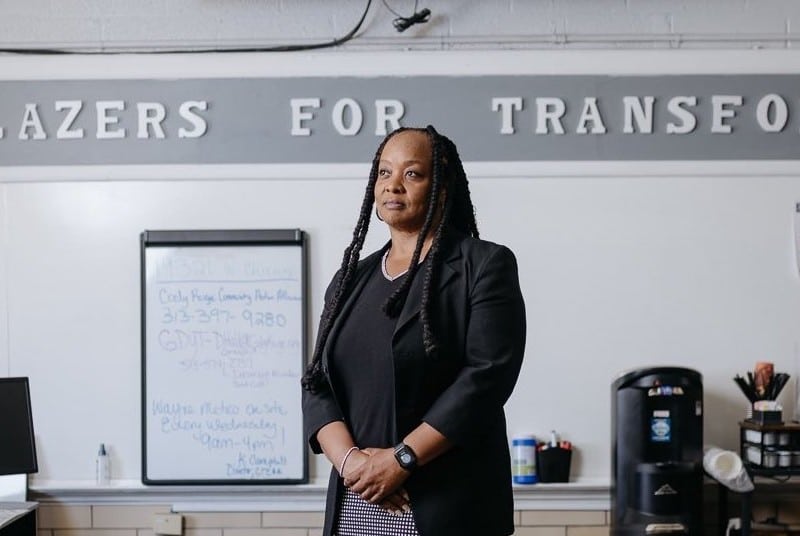Selling world-class talent on Detroit
Detroit may not have the prestige of Cambridge, Massachusetts, or the weather of Miami, but when it comes to recruiting global talent to work at its anchor institutions, the city has a lot to offer.
This is the second in a two-part series of stories on the workforce of Detroit’s anchor institutions. Read part one, which focuses on how anchors are developing and retaining local talent, here.
The prestigious, hallowed halls of Harvard University. The sunshine, sandy beaches, and cosmopolitan city life of Miami, Florida. The epicenter of rust belt decline and desolation that is Detroit, Michigan. All terribly reductive descriptions, to be sure. Still, to an outsider of any of these places, these aren’t uncommon perceptions. Each place has its own prevailing national narrative that, once attained, can be difficult to persuade otherwise.
Dr. Steven Lipshultz followed the aforementioned path, spending portions of his career at Harvard and the University of Miami before coming to Detroit. He’s now here as pediatrician-in-chief of Detroit Medical Center’s Children’s Hospital of Michigan, chair of Wayne State University Department of Pediatrics, and president of University Pediatricians. He’s also tasked with recruiting world-class physicians to come work at the DMC.
Dr. Lipshultz’s moving here was a big get for the city of Detroit and its residents. It also wasn’t a very hard sell.
“I knew that some of the best doctors and researchers in pediatrics have come from Detroit. I wanted to come see for myself,” he says. “I came and confirmed that one of the most important institutions in the world for birth care is here. We were using technology in Miami that was developed in Detroit. Once you get past the national narrative, you see the great quality of life here.”
There’s no doubt that that pesky national narrative can sometimes be a hindrance to attracting talent to Detroit. And when running a children’s hospital, you’re going to want the best possible doctors and staff available.
Dr. Lipshultz says that while getting some to commit to an initial visit can be a little difficult, “Once they visit, it sells itself.”
And it sells itself by investing in new facilities, infrastructure, and development. Not only the DMC, but many of the city’s top institutions are taking this same route.
According to Dr. Lipshultz, he’s already recruited 30 physicians this year and expects to hire another 30 next year, estimating that it’s one of the largest physician recruitment classes in the country. The multi-million dollar expansion of the Children’s Hospital is one of the largest of its kind nationwide, not only creating a need for more physicians, but demonstrating to those physicians that Children’s Hospital is serious about providing the most advanced pediatric care possible. Such investment only makes physicians want to work there even more, says Dr. Lipshultz. It further feeds that reputation which drew him here in the first place. Health care professionals want to work somewhere that’s serious about providing health care.
Selling Detroit as a world-class design hub
Narratives like Detroit’s drift much farther than Massachusetts or Florida. Provost Sooshin Choi of the College for Creative Studies relates a story that when giving a presentation in China on behalf of his institution, people there thought that Detroit’s then-bankruptcy had caused it to fall off the map. Provost Choi says that now that the city has exited bankruptcy, paired with the surge in investment in the city’s greater downtown, it’s been much easier to draw talent to the city.
Where before people wondered if Detroit was still on the map, CCS uses a headhunter that now pitches Detroit as a selling point, telling prospects that the city is the next Milan, Italy – another city known for design and industry. Recently, CCS hired a chair of the new Fashion Accessories Design department, luring Aki Choklat away from Italy. Provost Choi says Choklat had been reading about Detroit before he was recruited and jumped at the offer. Earlier this year, CCS hired Tim Flattery to chair its Entertainment Arts department, recruiting him away from a successful design career in Hollywood. Provost Sooshin himself, once a professional designer in South Korea, was recruited away from an administrative position at the University of Cincinnati.
There’s a lot that CCS uses to recruit national and international talent. As the college continues to improve its already highly-esteemed faculty and programming, it’s also nurturing a culture of design in Detroit outside of the classroom. As the city embraces its design culture more and more, it becomes more attractive to designers.
The renovated Argonaut Building, now home to the A. Alfred Taubman Center for Design Education, is a hive of creative industry. There’s the Detroit Creative Corridor Center (DC3), a self-described creative industries advocacy organization. DC3 started the Detroit Design Festival, which has grown in size and scope each year since beginning in 2011. Even Shinola, the trendy watch and bicycle company, calls the Argonaut home.
“A recent report from the National Bureau of Labor Statistics found that Michigan has more industrial designers than any other state in the country,” says Provost Choi. “We can emphasize that and bring even more in from out of state. And now that the city is out of bankruptcy, it makes it that much easier to recruit.”
Anchor institutions’ investment in place paying off
A greater investment by the city’s anchors institutions (hospitals, colleges, and universities) in place-based initiatives has done much for attaining and retaining a talented workforce in Detroit. The much ballyhooed Live Midtown initiative is a great example of this investment, with anchors Wayne State University, Henry Ford Health System, and Detroit Medical Center banding together to offer employees financial incentives for living within the borders of Midtown. So successful was the program that its boundaries were redrawn to include the area north of New Center, including the Boston-Edison neighborhood.
In numbers released by Live Midtown and Midtown Detroit, Inc. this past May, there were 1,042 unique participants that utilized the program since its 2011 start. Not only is the program helping to draw people from outside the city, state, and country, a sizable amount of Detroiters have used the Live Midtown money to stay in the city. The subsidies were used by 31 percent Detroiters, 37 percent from other parts of Michigan, 21 percent from out of state, and 11 percent from outside the country.
Many more place-based efforts go a long way in making Detroit more attractive to prospective workers. Facing a lack of housing options in the greater downtown area, Henry Ford Health System has been working on a plan to develop 300 acres south of the hospital, actively courting developers to build housing and mixed-use projects to make the area more appealing to its workforce and recruits. HFHS is also heavily involved in beautification efforts throughout their surrounding neighborhood. And Wayne State is working in a number of ways to make its neighborhood more pedestrian-friendly, accessible, and safe.
Ajay Parikh is director of human resources, shared services, and talent selection at HFHS. He says that in competing for a talented workforce, the development happening around greater downtown and the anchor institutions have helped draw talent to – and keep talent in – the city. People are noticing a change.
“People are much more open to coming to Detroit than three or four years ago,” says Parikh. “Look at the beautification, the new construction. You can see the evidence that this is the place and it is growing. You can show them all the new restaurants and it really affects their perception of Detroit and make them more likely work and live heto work and live here.”
This story is a part of a series of features on the impact of Detroit’s anchor institutions. Support for this series is provided by a coalition of organizations, including Henry Ford Health System, Detroit Medical Center, Hudson-Webber Foundation, College for Creative Studies, and Midtown Detroit Inc.
MJ Galbraith is Model D’s development news editor. Follow him on Twitter @mikegalbraith.
Photos by Nick Hagen.








